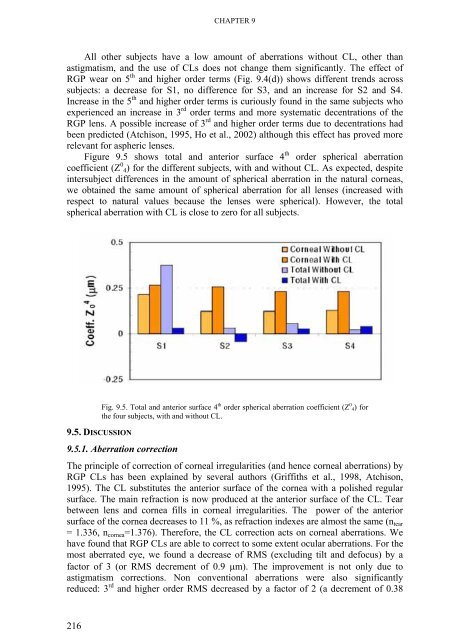Low_resolution_Thesis_CDD_221009_public - Visual Optics and ...
Low_resolution_Thesis_CDD_221009_public - Visual Optics and ...
Low_resolution_Thesis_CDD_221009_public - Visual Optics and ...
Create successful ePaper yourself
Turn your PDF publications into a flip-book with our unique Google optimized e-Paper software.
CHAPTER 9<br />
All other subjects have a low amount of aberrations without CL, other than<br />
astigmatism, <strong>and</strong> the use of CLs does not change them significantly. The effect of<br />
RGP wear on 5 th <strong>and</strong> higher order terms (Fig. 9.4(d)) shows different trends across<br />
subjects: a decrease for S1, no difference for S3, <strong>and</strong> an increase for S2 <strong>and</strong> S4.<br />
Increase in the 5 th <strong>and</strong> higher order terms is curiously found in the same subjects who<br />
experienced an increase in 3 rd order terms <strong>and</strong> more systematic decentrations of the<br />
RGP lens. A possible increase of 3 rd <strong>and</strong> higher order terms due to decentrations had<br />
been predicted (Atchison, 1995, Ho et al., 2002) although this effect has proved more<br />
relevant for aspheric lenses.<br />
Figure 9.5 shows total <strong>and</strong> anterior surface 4 th order spherical aberration<br />
coefficient (Z 0 4) for the different subjects, with <strong>and</strong> without CL. As expected, despite<br />
intersubject differences in the amount of spherical aberration in the natural corneas,<br />
we obtained the same amount of spherical aberration for all lenses (increased with<br />
respect to natural values because the lenses were spherical). However, the total<br />
spherical aberration with CL is close to zero for all subjects.<br />
9.5. DISCUSSION<br />
Fig. 9.5. Total <strong>and</strong> anterior surface 4 th order spherical aberration coefficient (Z 0 4) for<br />
the four subjects, with <strong>and</strong> without CL.<br />
9.5.1. Aberration correction<br />
The principle of correction of corneal irregularities (<strong>and</strong> hence corneal aberrations) by<br />
RGP CLs has been explained by several authors (Griffiths et al., 1998, Atchison,<br />
1995). The CL substitutes the anterior surface of the cornea with a polished regular<br />
surface. The main refraction is now produced at the anterior surface of the CL. Tear<br />
between lens <strong>and</strong> cornea fills in corneal irregularities. The power of the anterior<br />
surface of the cornea decreases to 11 %, as refraction indexes are almost the same (n tear<br />
= 1.336, n cornea =1.376). Therefore, the CL correction acts on corneal aberrations. We<br />
have found that RGP CLs are able to correct to some extent ocular aberrations. For the<br />
most aberrated eye, we found a decrease of RMS (excluding tilt <strong>and</strong> defocus) by a<br />
factor of 3 (or RMS decrement of 0.9 m). The improvement is not only due to<br />
astigmatism corrections. Non conventional aberrations were also significantly<br />
reduced: 3 rd <strong>and</strong> higher order RMS decreased by a factor of 2 (a decrement of 0.38<br />
216











